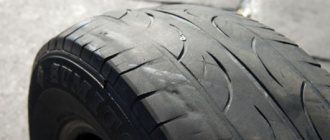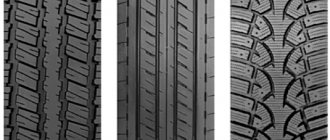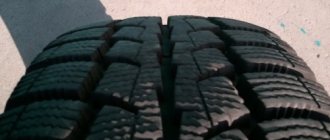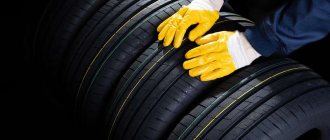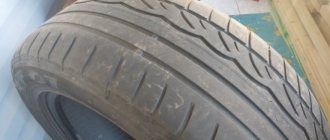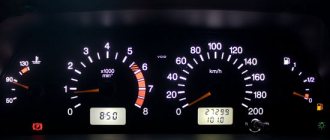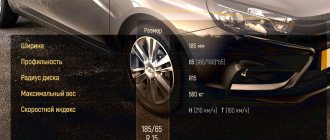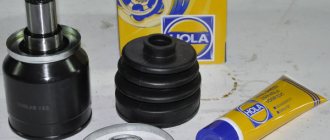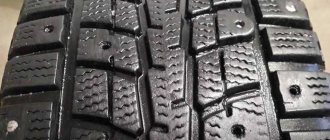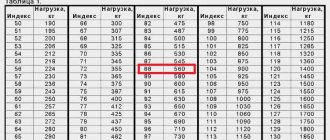Why does a car eat rubber on the outer and inner sides of the front wheels? Read and eliminate
Many car enthusiasts are interested in why the car eats rubber on the outer and inner sides of the front wheels. This problem is quite common. Moreover, the difficulty lies in the inability of the craftsmen to accurately determine the cause of the breakdown, but it always lies on the surface. Therefore, it is advisable for the owner to know the main types of breakdowns that lead to increased wear of parts. Some of the problems can be fixed right in the garage. This will allow you to avoid unnecessary trips to the service center, although no one has canceled the diagnosis. By knowing the reasons, you can avoid mistakes made by careless or inept mechanics.
Why does a car eat rubber on the outer and inner sides of the front wheels? Everyone knows that car tires wear out over time, and this primarily concerns the front wheels. There are several factors that influence this process. Actually, not too much tire wear is normal for a car. The tires on the inside of the wheel are worn off first. This is due to the presence of castor. In theory, under normal conditions, wear on a wheel becomes noticeable only after 2-3 seasons. With faster wear, it is necessary to look for the cause of the problem.
The main reasons for eating up tires on the rear wheels
So, this defect most often occurs due to the following factors:
- Of course, a violation of toe-in and camber, just like for the front wheels, is one of the main reasons for eating up rubber.
- It sometimes happens, especially in relation to domestic cars of old models, that the rear axle has dependent wheels, and it is a solid beam, it is not possible to check the position of the wheels on which and adjust them. In such cases, the causes of the defect may lie in non-design bends of the massive beam itself due to the car falling into a deep hole at speed, and the problem will have to be corrected at the exhaust stand.
- During tire fitting, mechanics often show irresponsibility by not using a torque wrench when tightening the nuts on the studs that hold the wheel to the hub. In such cases, misalignment may also occur and, as a result, eats the rubber from the inside, front or rear, with all the ensuing consequences.
- Unlike the front axle, for correct adjustment of the rear wheels it is extremely important to carry out all control measurements with a full tank, since it is located just at the back, and gasoline can weigh up to 50-70 kg. Thus, when adjusting the angle of the wheels with an empty tank during the next refueling, the car may well sag and the wheels will begin to eat up.
Rubber eating at the rear
- The last thing that is especially acute for cars with a large trunk, for example, SUVs, minivans or pickups, is the problem of overload, since drivers sometimes neglect the permissible curb weight of the car, the excess of which is often reflected in the condition of the suspension and, as a result, affects the alignment of the wheels. .
Why does it eat the tire from the outside front or rear?
More often the cause of such a defect is a broken camber. If its angle is too positive, excessive abrasion of the outer shoulders of the rubber is observed. The final conclusion is made only after examining the suspension parts, the essence of which we outlined in the previous section.
If the wheel alignment is set, the suspension is “normal”, but the rubber is still eating from the outer edge, then the problem is with the tires. There are plenty of examples of when it is enough to replace a set of tires with a new one, and problems with tread development at the rear and front immediately disappear.
For example, the Kama Euro 129 is distinguished by its fat on the outside: after 1,000-2,000 km, uneven tire geometry is observed. And this is another nail in the list of their shortcomings, although they are already not the most wear-resistant summer tires with a strong sidewall among the participants in the fresh test.
How much wear is acceptable?
The requirements for summer tires differ from similar operating conditions for winter tires.
The permissible tire wear for summer tires on passenger cars reaches 1.5 mm. When the indicator is 1.6 mm, it’s time to change the tires. Winter wheels have a more prominent tread pattern, therefore the abrasion depth is greater. Rubber used for driving in cold seasons can be worn down by 4 mm.
Trucks have their own indicators. Their tires can only be worn down 1 mm, and then they must be replaced. For buses, the wear rate is 2 mm of the worn rubber surface.
Methods for eliminating the causes of wear on truck and bus tires
To increase the life of truck and bus tires, you need to know the basic types of tire care. These include:
- wheel chamber pressure control;
- monitoring the external condition of the tire;
- control of location and operating mode.
A tire in normal condition has the following characteristics: there is a cap on the valve, there are no deep cuts on the tread, and there are no protruding threads. Before driving, you need to inspect the wheels to identify the presence of sharp objects in the tires.
It is very important to choose the right route. Road surfaces interspersed with stones significantly increase the wear rate of truck and bus tires. Do not overload the machine. Avoid sudden acceleration, frequent heavy braking, and maneuvering at high speeds. If the vehicle needs to be parked for a long time, it is recommended to inflate the tires to increase the pressure in them. When installing new tires, the wheels should be balanced.
Types of abnormal wear
The most common types of uneven wear are:
- Tire wear along the edges of the tread on both sides (along the entire circumference).
- Tread wear in the central part (around the circumference).
- One-sided edge wear.
- Abrasion of the sidewall or middle part of the working surface (in places).
- Hernia on the wheel.
- The appearance of a plane on the surface of the tire.
Tire wear on both edges
Let's go through each type. So, wear along the edges on both sides of the rubber (visually you can see that the tread on the sides is worn out much more than in the central part) indicates that the pressure in the wheels is below normal. This happens because the tire bends in the central part, and the main load falls on the side areas. It is worth noting that this result is caused by operating tires with insufficient pressure for a significant period.
Wear of the central part of the tread
But wear in the central part indicates excessive tire pressure. Under such conditions, the roundness of the working surface is higher, so only the middle part of the tread is in contact with the road, and the side parts simply do not touch it.
One-sided tire wear
One-sided wear, most often this is wear on the inside of the rubber - the result of incorrectly set camber/toe angles. If wear is noticed on the inside, then the corners are strongly tilted in the negative direction, and wear on the rubber on the outside means that the camber value is positive (for front-wheel drive cars, these angles should be 0).
The above listed rubber wear occurs around the entire circumference of the wheel. But it often happens that abrasions on a tire look like spots, and there may be several or just one. Typically, these types of wear occur in the middle part of the tread, although they also occur on the side areas.
If there are several such spots, and they are located in a circle, then this may indicate:
- wheel imbalance;
- violation of the geometry of the brake system elements (ovality of the drum or waviness of the disc). As a result, during intense braking in certain places, the wheel simply blocks, thereby exposing the same section of the tire to increased friction;
- excessive wear of the suspension, steering mechanism;
Tire wear due to emergency braking
But if only one spot is noticed, then this is the result of emergency braking, during which the wheels were completely blocked.
Hernia on the wheel
The appearance of “bumps” on the tire is the result of the use of low-quality cord in the design, strong impact loads, under which the cord threads simply break and the tire loses strength.
Tire deformation during long-term parking
The appearance of a platform (flat surface) on the tire circumference is the result of a car being parked for a long time without moving. Therefore, the section of the wheel that was in contact with the canvas took its shape. At the same time, if you do not pay attention to this and start using the car, then increased loads (beating) will occur at this site, which will lead to the appearance of an erased spot. But this type of wear is very easy to eliminate by inflating the wheels, after which the car needs to be moved and left for a while (air pressure will restore the surface).
All of the listed types of wear (except the last) affect traffic safety, so such tires already require replacement, although not urgently (does not apply to the appearance of hernias on the wheel). But they will still have to be replaced in the near future.
Internal wheel wear: opinions of car owners
- “You hit a hole, check the camber” After you hit a large hole on the road with your wheel, you should do a camber diagnosis. Many drivers neglect this rule. Moreover, they do not check the camber even during routine maintenance, and the car services themselves ignore this procedure. We often think about camber only when the car begins to actually eat rubber. At the same time, we often scold everyone around us, although our guilt in what happened is obvious.
- “Careful with overload!” When a car is overloaded, its wheels become a “house”. This is due to the features of the rear multi-link suspension, which is designed to ensure safe cornering. Therefore, if you often drive a car with a full load, you need to either accept the accelerated internal wear of the wheels for granted, or “cheat” the suspension design by adjusting the toe-in when the car is partially loaded (you can throw a couple of bags of potatoes in the trunk).
- “Increased internal wear during sharp turns” When the car sharply enters a turn, poorly inflated tires break, which is why the inner edge of the wheel begins to work more (accelerated wear occurs in this place). My car had this type of internal wear on all wheels. I admit, I didn’t control the tire pressure for a long time.
- “Take into account the loading of the car when performing wheel alignment” I recommend that you always adjust the camber on a loaded car and display the indicators at the beginning of the upper tolerance limit. The fact is that when exposed to different forces while the car is moving and there are a large number of silent blocks on the chassis, the parameters change very much. That is why the desired result is achieved. For example, the toe-in is set exactly according to the required parameters, but after the driver sits down, the front wheels begin to diverge and the toe-in indicators go into the red zone. If 2 passengers sit in the back of the car, then the camber also becomes abnormal.
- “3D alignment is not a panacea” After purchasing new tires, I made an alignment on a 3D stand. After that, I drove the car around, periodically checking the wear of the tires, and after a while I discovered that the tread was eaten unevenly. I visited many different services and checked the camber at different stands, but as a result, I brought all the indicators of the wheel alignment angles to such zones to ensure uniform tire wear. My recipe for uneven tread wear is to buy new tires and have the camber adjusted professionally on a high-precision stand.
Common problems
When considering why the Fiat Albea has tires with varying degrees of wear, it should be noted that in some cases the problem manifests itself after several hundred kilometers of travel. Let us highlight the following reasons why rubber is consumed unevenly:
Incorrect alignment, which can occur after some time of operation of the vehicle and with a strong impact. Internal wear often occurs for this reason. Therefore, many people pay attention to it when checking the tread.- Incorrect tire pressure can also be cited as the reason why wear occurs on the inner or outer side after some time.
- Low pressure can also cause uneven wear. Those who like to ride on flat tires constantly change their tires.
- Defects in manufacturing. It is quite rare to encounter a situation where the cause of the phenomenon in question is a manufacturing defect. That is why you should pay attention when choosing to offer only trusted manufacturers.
- Tire aging. It is quite rare for tires to be used after they have been manufactured for several years. This is due to the fact that a large number of cars determines a high need for the product in question. Therefore, all tires are bought up quite quickly.
There are quite a lot of answers about what is eating rubber. A Fiat or other car should be checked according to a certain scheme to identify the problem. This is due to the fact that even a simple reason that takes little time and effort to eliminate can lead to significant problems.
Causes of car tire wear
The reasons for wear of car tires can be different, it may depend on the driver’s driving style, due to untimely maintenance, and tire tread wear can also indicate that it’s time to do the geometry.
But experts have identified the main causes of wear:
1. Incorrect tire pressure and failure to comply with the pressure required for the car.
2. Overloading the car also affects the vehicle manual; the permissible load on the tires and its standards must be written.
3. Violation of vehicle operating rules while driving.
4. Wheel balancing is off.
5. Not passing the car on time
6. Installation rules were violated.
7. Malfunction in the steering and chassis of the car.
As you can see from this list, you can understand that tire wear occurs due to the driver’s negligence, maintenance regulations are violated and improper operation of the vehicle.
Another important factor is the wear and tear of tires; their expiration date is not recommended; use is not recommended if car tires are more than 10 years old, since the rubber cracks over time (even if it has been standing), moisture begins to seep inside and destroy the metal cord.
An explosion of rubber, especially while driving, can lead to dire consequences; for driving safety, change tires every 10 years, or even less. Rubber loses 10% of its service life every 3 years.
Tire aging
Even though rubber typically wears out before it reaches its expiration date, there are certain deadlines. Aging rubber can cause it to wear unevenly and severely. It is also worth noting that improper storage can lead to rapid aging of rubber.
All manufacturers indicate how long a product can last under certain operating conditions. It also indicates how it should be stored.
Aging of rubber leads to the fact that it loses its tightness and the structure becomes porous. After some time, moisture begins to penetrate deep into the structure. As a rule, manufacturers use metal cord to strengthen the structure. Moisture leads to the destruction of the metal base. According to accepted standards, a tire cannot be used after 10 years from the date of its manufacture.
Long-term diagonal dent and severe tread wear
This problem is relevant for the rear axle of a front-wheel drive car. Most often it occurs when a passenger car is operated in cargo mode, that is, it often transports weights for which it is not designed. Taxi drivers can also often experience a similar problem.
If the car is not used as a means of constantly transporting heavy loads, but at the same time it has a similar problem, the reason for this is incorrect alignment. As a result, before installing new tires on a car, it is necessary to check the wheel alignment and set it to zero.
Tire wear | Autoblog
Winter is slowly but surely coming to an end. Soon you will need to change back to summer tires. But until she has changed her shoes, she needs to carry out a technical inspection, check for wear. After all, it will help you identify hidden defects in your car, as well as suggest correct operation...
Today I want to teach you how to identify hidden defects using tire wear. Many of us, especially those who started their driving careers with our VAZ 2101 - 2106, remember wear and tear on the inside. Sometimes such that the inside of the wheel turned out to be completely “bald”. At the same time, they continued to drive on such a tire before. I myself, when I was just starting my driving career, this was 15 years ago, also killed tires, this happened on my first car, a VAZ 2101. Then I did not know why this was happening. But in vain, this knowledge would have helped me save the tire. If you have wear and tear and don't know where it comes from then the following information is for you.
It's all about the alignment of the car. If these settings are violated, then wear is guaranteed. To begin with, without delving into the essence of the issue, I will say that it is very easy to reset these settings (alignment - camber). At high speed we flew into a large hole, so that the disk was bent, all this was enough to throw off these settings. And accordingly, wear may occur. Therefore, after a strong blow to the suspension, you need to go to a service station and check the wheel alignment settings. This is my advice to you, otherwise it will cost more later when the rubber “covers up.” And tires are not cheap now.
Epilogue
In conclusion, we note that timely detection of the problem will eliminate the problem and preserve the integrity of the tire. Timely detection of the problem is possible by constantly visiting a service station. When inflating wheels or diagnosing the suspension, you should pay attention to the condition of the tread.
Tired of paying fines? There is an exit!
Forget about fines from cameras! An absolutely legal new product - Traffic Police Camera Jammer, hides your license plates from the cameras that are installed in all cities.
More details at the link.
- Absolutely legal (Article 12.2);
- Hides from photo and video recording;
- Suitable for all cars;
- Works through the cigarette lighter connector;
- Does not cause interference to radios and cell phones.
The outer tread blocks have convex wear
Diagnosing such a problem is the most difficult because it is not visible visually. To determine the presence of convex wear on the side edges of the tread, you need to run your finger along them. You can feel that the low edges of the tread block are worn into a rounded shape, while the high edges, on the contrary, are pointed. If a similar problem occurs on your car, you need to check the wheel bearings and ball joints. It is worth noting that the outer tread blocks may wear out on one tire, while the rest will be fine.
How to determine tire wear
The Main Causes of Uneven Tire Tread Wear
Some car owners wonder how to know when it's time to install a new set of wheels. First you have to learn how to determine how worn they are. Not every driver knows how to do this. Therefore, dangerous situations occur when the tires are completely worn out on the track or while traveling. There are several ways to determine if tires need urgent replacement. Let's look at each of them in more detail.
Visually
The easiest way to determine the suitability of tires is to conduct a visual inspection. However, no one guarantees that the results obtained will be 100% accurate.
Tires must be replaced if, during a visual inspection, you find that:
- the wheels have cuts, cracks and other defects;
- the tread is worn unevenly, one part of it is intact, the others have worn away so much that the cord is visible;
- The rubber has worn off from the inside. This may happen because it comes into contact with any part of the car and wears off;
- there are bumps on the tires. This indicates that the wheels are worn out and need to be replaced.
- Measuring the tread height
To find out how badly the wheels are worn and whether you need to buy a new set of tires, you will have to get a caliper. It makes it easy to determine the tread height. Of course, you can also use a ruler with a depth gauge or other device. How can you find out what the tread thickness is in millimeters and how worn the tires are? To do this, take measurements in several places, because tires can be worn unevenly.
If you are convinced that the tread height meets the manufacturer's recommended values, then the tires can continue to be used. Otherwise, you should install a new set of wheels as soon as possible. After all, driving on worn-out tires can lead to irreparable consequences, especially in extreme road situations.
According to wear indicator
Many tires have a special indicator that shows how worn the tire is. Is it at the same height as the tread? This means that the wheels need to be replaced as soon as possible, because they are worn out. Most often the indicator has 4 digits. On summer tires, the permissible wear is up to 2-3 mm, on winter tires - up to 4-6 mm.
Don't forget that winter wheels may have studs. When 60% of them have fallen off, it means that the wheels have become unusable. After all, without studs, winter tires will not be able to provide the required grip on the road surface.
Why you need to pay attention to tire wear when buying a used car
If you are buying a used car, during the inspection it is important to pay attention to the condition of the tires; they can tell a lot (of course, if the tires are not new). As mentioned earlier, uneven tire wear can mainly be caused by the following reasons:
- Tire pressure is incorrectly adjusted.
- The wheel alignment angles are set incorrectly.
- There are faults in the suspension - there is play in the tie rods/tips, the silent blocks are worn out, the arms are bent, the shock absorbers require replacement, and so on.
- Wheel rims are deformed, causing imbalance.
- The geometry of the body is broken.
If the first four points are quite easy to deal with, and the cause of the malfunction can be eliminated, then with a violation of the geometry everything is more complicated; it may be violated as a result of a serious accident, and in this case it may not be possible to correct anything. Therefore, before buying a car with unevenly worn tires, you should ask the real owner to diagnose the car at a service station, and only after making sure that the body is in normal condition should you carry out the purchase and sale transaction.
The importance of correct tire pressure
Tires are inflated to a certain pressure so that the car can drive smoothly on the roads and maintain its weight. If the pressure is incorrectly set, fuel consumption increases, tires wear out prematurely, and the car handles and brakes worse.
The statement that on any passenger car you need to inflate tire pressure to 2 atm is incorrect; for each car the manufacturer sets its own parameters, usually they are indicated on the central pillar of the car on the driver's side, and information can also be marked on the gas tank flap from the inside.
When measuring with a pressure gauge, it is important to take into account that in warm weather the pressure in the tires increases, so you need to inflate the wheels in accordance with the season and the temperature at which the car is operated. And measurements must be taken at least once every three months, and before each trip you should inspect the condition of the tires
Chevy Aveo tires.
Reading time: 7 minutes
Any experienced car enthusiast knows that for normal operation of a vehicle, it is not enough just to select the necessary tire, install it on the wheel, balance it and drive without the risk of accidents and premature wear. One of the most important actions that a car must undergo is adjusting the camber and toe, that is, aligning the position of the wheels in the horizontal direction to prevent excessive abrasion of the rubber.
Other reasons
The above reasons can lead to severe abrasion of the surface after several hundred kilometers. However, some malfunctions can also lead to minor wear, which will appear after several thousand kilometers. Such reasons include:
- Suspension fault. If the front suspension is associated with wheel alignment, then eating up the rear tires may be due to a faulty suspension. Incorrect placement of certain elements can cause the wheels to be positioned at a certain angle. An example is a violation of the position of the racks, as well as levers and other elements that influence the position of the rim.
- Changes in body geometry after an impact can also cause uneven wear. It is possible to identify such a situation only if you have certain equipment.
- The characteristics of the disk used can also lead to the problem in question. For example, after a strong impact, the shape of the disc may be disrupted.
The above reasons can also lead to abrasion on the inside of the tire. However, they are quite rare. The geometry of the body changes after a strong impact, suspension malfunctions that lead to wheel tilt are often corrected earlier, and modern rims are highly durable.
Wear of steered and drive wheels
An important point is that it eats rubber on the inside and outside of the drive and steered wheels differently, even in the absence of a malfunction. This is due to the following points:
- At the moment of turning, the steered wheels adhere to the road surface with the inner or outer side of the tire, which is due to the characteristics of the steering system. Therefore, Fiat Albea may have tires with uneven wear. However, a similar phenomenon appears after several thousand kilometers.
- The wheels to which torque is transmitted wear out more in the middle - they eat rubber in the place where the load and friction force are concentrated.
If the driven wheels are driving, then the two phenomena are summed up and uniform wear occurs. A similar phenomenon is typical for a front-wheel drive vehicle. Why tires eat unevenly in this case - the answer lies in the presence of a malfunction.
Current issues
Why does the wheel alignment go wrong?
A bad road has a negative impact not only on the life of chassis components. It also leaves a negative imprint on their mutual position. Timely control of adjustments is necessary in the following cases:
- After a strong impact on the curb, holes, potholes and other uneven road surfaces.
- Upon completion of replacement of suspension elements.
Attention! Wear on the consumable components of the suspension structure also disrupts the installation angles.
The components are original and the wheel alignment is correct: the tire still wears unevenly
It is likely that the hub bearing has become unusable. If there is such a malfunction, it is difficult not to notice the play by rocking the wheel in different directions. While it is possible to deal with this ailment, it is difficult to change the incorrect geometry of the body. And due to the bent load-bearing part, there may well be rubber on the inside of the back or front of the car.
Premature wear does not meet the above criteria
Cases of asymmetrical “eating” of rubber products are discussed above. The following cases of tread wear should be classified as symmetrical:
- On both sides: low tire pressure.
- Center: increased tire pressure.
There are often situations when on the front/rear axle one of the tires works faster than the other. The only argument in favor of this state of affairs is the different pressures in tires located on the same axle. As a result, the car pulls to the side and there is increased friction in the wheel with less air.
The collapse of convergence
Eating may occur on the inside or outside due to the incorrect location of the wheels relative to the vehicle body. In this case, after a long time, severe abrasion can occur on either side. When considering such a problem, the following nuances should be noted:
- Camber is an indicator that is responsible for the tilt along the vertical axis.
- Toe is an indicator that is responsible for the position of the wheel when turning.
Such indicators apply only to the front axle. What can seriously eat up the wheels after a few kilometers of travel?
If you change the wheel alignment settings, the cord wears out. At the same time, it eats the cord differently, depending on how the set parameters were reset. After a few hundred kilometers, the problem can manifest itself clearly, up to complete wear of the tread to the base of the cord.
Considering this question, we note the following:
- If it eats the inner side, then this indicates an excessive inward tilt. This situation is called negative camber. This situation occurs quite often.
- If the outer edge wears quickly, then this is positive wear. In this case, the wheels are tilted in different directions.
After 300-500 kilometers of travel, even a new tire can become completely unusable. However, it is worth considering that zero camber leads to uniform, but increased wear. This situation also leads to a significant increase in fuel consumption, and also increases rolling resistance.
The settings are reset for the following reasons:
- Due to prolonged use of the vehicle without proper maintenance.
The alignment condition should be checked periodically. Long-term operation of the car on bad roads, which causes constant exposure to various loads, necessarily leads to changes in settings. - If there is a strong impact while driving. Often, when hitting a curb or other serious obstacles, the alignment indicators change. Therefore, after such contact at high speed, the wheel alignment indicator should be checked.
- When carrying out any work related to the front suspension of the car. Carrying out repair work leads to the settings being lost. However, not all works cause this phenomenon.
- If important suspension elements are defective. Severe wear of the suspension elements also leads to the wheels being at the wrong angle to the body.
Checking the wheel alignment at a service station takes a little time. Modern equipment allows you to perform a quick and accurate alignment check. Experienced craftsmen perform the work of setting the required parameters within a short time.
Tire cracks
Another problem that can result from high or low tire pressure is cracking.
A tire hitting a curb or hole is a stressful condition for the tire, which it can withstand without damage at ideal pressure. If longitudinal cracks appear on the sidewall of the tire, it means that it has been used for a long time at insufficient pressure. Also, small cracks may appear on the tire, and from them you can tell that the rubber has reached the end of its service life. In such tires, the chemical decomposition of elements begins, which allow it to maintain its properties. It follows from this that the use of such tires is prohibited.
Why does the tread eat unevenly?
Look under the front bumper from the front of the car - the wheels are not perpendicular to the road, but slightly inclined. Some inside, some outside. In general, the collapse, and what you see in this plane is called that way, can be positive and negative. It’s easier to figure out which one is which by looking at the photo.
For your information. Camber, toe, caster are three suspension settings that are found in any car (some of them may not be adjustable, but they exist and are ensured by the rigid relative arrangement of parts). In theory, these are just names of the angles of the wheels in different projections. After all, the tires are deviated from all three planes (in the spatial dimension there are precisely three planes).
Why not place the wheels rigidly straight in all planes? Why all these adjustments in the suspension? Here is a table showing what role each angle plays.
| Purpose of suspension settings | |
| Name | What provides |
| Camber | Increases the area of the tire contact patch with the road |
| Convergence | Compensates for the elastic movement of suspension parts (silent blocks and other rubber bands) |
| Custer | Helps return the steering wheel to its original position |
All values of these three characteristics are indicated in degrees (°), and if necessary, they are expressed to arc minutes and seconds. Each car has its own. Look for the true values in the operating manual, and the actual values on the printout that should be given at the wheel alignment.
Deviations from these angles are not allowed, otherwise the tire will be eaten from one side. However, the suspension is not always to blame. A banal difference in tire pressures also does not lead to anything good. What exactly is the reason will be revealed by the nature of the “zhora” of the wheel, photos of which you have already looked at.
Basic mistakes when adjusting the front wheels
Many experienced car enthusiasts have encountered such a problem when, after the next scheduled maintenance, the inside of the front wheel suddenly begins to wear out. This is primarily due to a violation of technology during the adjustment of toe-in and camber, since this procedure must be carried out on a special stand using appropriate equipment and professionally trained craftsmen. If the procedure is carried out with violations, then a result occurs called critical adjustments, which is expressed in the following criteria:
- Regardless of the class of the passenger car, when adjusting the camber, it is advisable to maintain a negative angle for the front axle, because the mechanism for turning the constant load from the engine brings them into balance in this position.
- When setting the correct toe angle, that is, the positioning of the wheels in relation to the horizontal surface, it is, on the contrary, necessary to give the value only positive values in order to achieve ideal balance while driving at high speed. It is this kind of adjustment that can guarantee that the grip spot with the road, if the wheel is not overinflated relative to standard values, will cover the entire area of the wheel sole, which in turn will ensure ideal traction and transmission of all torque to the tire without any losses.
Caster Angle Adjustment
The last important indicator, which many tire service technicians completely neglect, is caster. This parameter is an angular value that characterizes the inclination of the projection of the vertical plane across the diameter of the wheel relative to the perpendicular, lowered strictly vertically from the point of attachment of the disk to the hub
The importance of correct positioning of this parameter is obvious, since automatic return of the steering wheel to its original position is possible only if correct adjustment is ensured. Accordingly, a correctly aligned steering linkage can guarantee that the wheels will be aligned strictly coaxially with the trajectory of movement, and during driving there will be no effect of their partial skidding, which is inevitably accompanied by abrasion of some of the treads.
Thus, after 10,000 km of mileage after incorrect adjustment of toe-in and camber, tires may have a difference in tread height on the central and inner parts of up to 5-6 mm, which indicates the need to replace them, since such a defect cannot be restored in any way even after wheel alignment.
Correct adjustment of toe and camber at service stations
If a driver notices one-sided wear on the sole of his tire, this should signal him that he needs to contact a tire service in the near future. Otherwise, eating up the rubber can lead to more serious consequences, including the formation of a hernia, or sudden rupture of the wheel, which can pose a danger to the driver or his passengers, as the car loses control.
How to check and adjust the alignment of the front wheels (front suspension)?
Why does it eat rubber?
What to do if you eat rubber from the inside front: possible reasons
A non-standard situation often occurs in the form of different wear on tires mounted on the same axle. Let’s say the right wheel “ate” from the outer end, the left one from the inner end. The exact reason is an incorrectly performed operation to adjust the geometry of the relative position of the suspension elements.
The real reason
The list of actions in the case of rubber eating on the outer side in front is partly relevant when identifying rapid wear of the inner shoulders. When identifying increased abrasion of the treadmill from the inner edge, the nature of the malfunction should be classified into one of the following groups:
- The side checkers are erased evenly - the camber angle is adjusted incorrectly.
- Saw-tooth herringbone wear – toe-in is not up to standard.
Options for combining the fixed types of worn tread geometry cannot be ruled out. Under such circumstances, experts talk about incorrect settings for both camber and toe.
For your information. Not all vehicles provide the ability to adjust all three wheel angles. If there are defects and there are no necessary adjustments, the cause should be sought in non-original and worn suspension components (silent blocks and other bushings). Factory defects in tires or incorrect adjustment of landing gear levers should not be discounted.
There are often cases when the rear “eats” rubber on one of the sides. Worn rear suspension silent blocks are a likely cause of the malfunction. However, tuned struts and various types of spacers can also cause deviations in the geometry of the tires used.
The problem is definitely not wheel alignment.
- Eats rubber around the edges. There is only one reason for this: the tire has low pressure.
- The tire was eaten in the middle. This happened because she had high blood pressure.
- On one axle, the right tire wears out faster than the left, or vice versa. Due to the difference in pressure between wheels located on the same axle, the car is pulled to the side with a tire with a reduced air volume. The same cylinder experiences additional frictional force, which causes it to wear out faster.
- The wheels wear out in bumps. Occurs due to imbalanced balancing, resulting in lateral runout of the disc.
If the suspension parts are not deformed, the consumables are fresh, the angles are within tolerance, the tires are new, and the balanced wheel still wears unevenly, check the body geometry. There are plenty of cases when even after a minor accident there was a problem with one of the tires.
Car tires, like all parts in a car, have their own specific service life; as a rule, with careful use and normal quality, tires last from 4 to 6 years. But intensive premature wear of tires often occurs; as motorists say, it eats rubber. Tires can be “eaten” in different places on the tread; wheel wear occurs on both the front and rear axles.
It is not easy to say unequivocally why rapid tire wear occurs; sometimes it is difficult even for experienced drivers to find the reason. But in many cases, the “zhor” of tires indicates existing faults in the car that need to be corrected.
Bald spots on the tire
If there are certain areas on a car tire that are more worn than the rest, they are usually called “bald spots” or spots. Most often, such spots appear on the cars of drivers who like to accelerate and brake sharply. During rare (including emergency) braking, if the car does not have an ABS system, the wheels are blocked and the car slips on the tire along the road surface. Sliding leads to an increase in tire temperature and immediate wear.
In addition, spots on your car's tires can appear if it sits idle for a long time. When parked for a long time, a separate section of the tire bears the entire weight of the car. Due to its structure, it can become deformed over time.
Why are my tires deteriorating faster than expected?
When tires have to be changed once every year or two, the motorist, counting the costs, becomes furious. However, in vain. In such a situation, it is better to calm down and understand why the tire tread wears out so quickly.
Let's measure the pressure
Often the cause of premature tire wear is unacceptable air pressure. Moreover, tires with both excess and insufficient pressure quickly respond. If you measured this indicator once and were satisfied, this does not mean that it will please you in a month.
The air is gradually released. This happens especially quickly in hot weather. The tire begins to spin “to break” and wears out quickly. However, low pressure can lead not only to rapid wear of the tire, but also to increased fuel consumption, since the wheel acquires increased rolling resistance.
Gaining experience
Tires often wear out faster for inexperienced drivers. They suddenly “take off” and also brake sharply. Due to increased friction, the tread pattern wears off much faster than usual. To ensure that your tires remain roadworthy for a long time, you should drive smoothly.
Let's dump the ballast
Increased vehicle load is also very likely to cause accelerated aging. It should be remembered that any car has a limited carrying capacity and if there is an excess of weights, not only the tires, but also other mechanisms lose their “health”.
Acquiring useful habits
It is advisable to inspect your tires regularly. Glass and sharp-edged stones constantly get clogged into the grooves of the tread. They damage the rubber. Over time, these damages grow and lead to significant deformation.
We trust professionals
Poor installation of tires or wheels can also cause accelerated deterioration. It is recommended that only specialists carry out this work, however, various craftsmen will never miss the opportunity to save money and carry out the installation themselves. Sometimes things work out quite well for them, but this is not always the case. In such cases, if there are problems, there is no point in scolding the tire manufacturer.
Finding balance
And finally, another common cause of accelerated damage is wheel imbalance. However, with such problems, the driver will probably pay attention to the tires last. He will be much more concerned about damage to other parts of the car, as well as simply an unpleasant and uncomfortable ride. However, if the wheels were unbalanced, you need to check the tires. Most likely they will be erased.
